A Numerical Study Based on Haar Wavelet Collocation Methods of Fractional-Order Antidotal Computer Virus Model
Abstract
1. Introduction
2. Model Structure
- The network grows by by adding new computers;
- Every group’s death rate, other than those caused by viruses, is ;
- Susceptible S gets infected at a rate determined by the probability of infection when interacting with an infected computer. With a factor of , the rate is proportional to ;
- At a rate , the transfer of susceptible to antidotes is proportional to . This means that the susceptible computer effectively communicates with the antidote, which installs its own antivirus on the antidote machine;
- An infected computer with an antivirus program effective against known viruses becomes either an antidotal computer at a rate proportional to , or becomes vulnerable to further infections at a rate ;
- Since viruses are found and eradicated, infected computers continually return susceptible ones at a constant rate of c. Some antivirus software, though, is not sufficiently potent to eliminate all malware;
- At a rate , removed machines can be recovered and transferred to vulnerable ones.
3. Fundamental Preliminaries
Fractional Extension of the Model
4. Qualitative Analysis
- : ∃ constants such that
- : ∃ constant such that
5. Stability Criterion
6. Numerical Analysis of Model
Numerical Scheme
7. Graphical Results
8. Concluding Remarks
Author Contributions
Funding
Data Availability Statement
Acknowledgments
Conflicts of Interest
References
- Han, X.; Tan, Q. Dynamical behavior of computer virus on Internet. Appl. Math. Comput. 2010, 217, 2520–2526. [Google Scholar] [CrossRef]
- Kim, J.; Radhakrishana, S.; Jang, J. Cost optimization in SIS model of worm infection. ETRI J. 2006, 28, 692–695. [Google Scholar] [CrossRef]
- Piqueira, J.R.C.; Araujo, V.O. A modified epidemiological model for computer viruses. Appl. Math. Comput. 2009, 213, 355–360. [Google Scholar] [CrossRef]
- Billings, L.; Spears, W.M.; Schwartz, I.B. A unified prediction of computer virus spread in connected networks. Phys. Lett. A 2002, 297, 261–266. [Google Scholar] [CrossRef]
- Gan, C.; Yang, X.; Zhu, Q.; Jin, J.; He, L. The spread of computer virus under the effect of external computers. Nonlinear Dyn. 2013, 73, 1615–1620. [Google Scholar] [CrossRef]
- Gan, C.; Yang, X.; Liu, W.; Zhu, Q. A propagation model of computer virus with nonlinear vaccination probability. Commun. Nonlinear Sci. Numer. Simul. 2014, 19, 92–100. [Google Scholar] [CrossRef]
- Muroya, Y.; Enatsu, Y.; Li, H. Global stability of a delayed SIRS computer virus propagation model. Int. J. Comput. Math. 2013, 91, 347–367. [Google Scholar] [CrossRef]
- Mishra, B.K.; Pandey, S.K. Dynamic model of worms with vertical transmission in computer network. Appl. Math. Comput. 2011, 217, 8438–8446. [Google Scholar] [CrossRef]
- Yang, L.X.; Yang, X.; Wen, L.; Liu, J. A novel computer virus propagation model and its dynamics. Int. J. Comput. Math. 2012, 89, 2307–2314. [Google Scholar] [CrossRef]
- Yang, L.X.; Yang, X. The spread of computer viruses under the influence of removable storage devices. Appl. Math. Comput. 2012, 219, 3914–3922. [Google Scholar] [CrossRef]
- Feng, L.; Liao, X.; Li, H.; Han, Q. Hopf bifurcation analysis of a delayed viral infection model in computer networks. Math. Comput. Model. 2012, 56, 167–179. [Google Scholar] [CrossRef]
- Ren, J.; Yang, X.; Yang, L.-X.; Xu, Y.; Yang, F. A delayed computer virus propagation model and its dynamics. Chaos Solitons Fractals 2012, 45, 74–79. [Google Scholar] [CrossRef]
- Mishra, B.K.; Jha, N. Fix period of temporary immunity after run of anti-malicious software on computer nodes. Appl. Math. Comput. 2007, 190, 1207–1212. [Google Scholar]
- Yang, L.X.; Draief, M.; Yang, X.F. The optimal dynamics immunization under a controlled heterogeneous node-based SIRS model. Physica A 2016, 450, 403–415. [Google Scholar] [CrossRef]
- Zarin, R.; Khaliq, H.; Khan, A.; Khan, D.; Akgül, A.; Humphries, U.W. Deterministic and fractional modeling of a computer virus propagation. Results Phys. 2022, 33, 105130. [Google Scholar] [CrossRef]
- Zhu, Q.Y.; Yang, X.F.; Yang, L.X. A mixing propagation model of computer viruses and countermeasures. Nonlinear Dyn. 2013, 73, 1433–1441. [Google Scholar] [CrossRef]
- Kephart, J.O.; White, S.R. Measure and Modeling Computer Virus Prevalence. In Proceedings of the IEEE Computer Society Symposium Research in Security and Privacy, Oakland, CA, USA, 24–26 May 1993. [Google Scholar]
- Podlubny, I. Fractional Differential Equations; Academic Press Elsevier: New York, NY, USA, 1999. [Google Scholar]
- Pinto, C.M.A.; Machado, J.A.T. Fractional dynamics of computer virus propagation. Math. Probl. Eng. 2014, 2014, 476502. [Google Scholar] [CrossRef]
- Ansari, M.A.; Arora, D.; Ansari, S.P. Chaos control and synchronization of fractional order delay-varying computer virus propagation model. Math. Meth. Appl. Sci. 2016, 39, 1197–1205. [Google Scholar] [CrossRef]
- Fernandez, A.; Baleanu, D.; Srivastava, H.M. Series representations for fractional-calculus operators involving generalised Mittag-Leffler functions. Commun. Nonlinear Sci. Numer. Simul. 2019, 67, 517–527. [Google Scholar] [CrossRef]
- Khan, A.; Zarin, R.; Khan, S.; Saeed, A.; Gul, T.; Humphries, U.W. Fractional dynamics and stability analysis of COVID-19 pandemic model under the harmonic mean type incidence rate. Comput. Methods Biomech. Biomed. Eng. 2022, 25, 619–640. [Google Scholar] [CrossRef]
- Almeida, R.; Morgado, M.L. Analysis and numerical approximation of tempered fractional calculus of variations problems. J. Comput. Appl. Math. 2019, 361, 1–12. [Google Scholar] [CrossRef]
- Fernandez, A.; Ozarslan, M.A.; Baleanu, D. On fractional calculus with general analytic kernels. Appl. Math. Comput. 2019, 354, 248–265. [Google Scholar] [CrossRef]
- Jitsinchayakul, S.; Zarin, R.; Khan, A.; Yusuf, A.; Zaman, G.; Sulaiman, T.A. Fractional modeling of COVID-19 epidemic model with harmonic mean type incidence rate. Open Phys. 2021, 19, 693–709. [Google Scholar] [CrossRef]
- Zarin, R.; Ahmed, I.; Kumam, P.; Zeb, A.; Din, A. Fractional modeling and optimal control analysis of rabies virus under the convex incidence rate. Results Phys. 2021, 28, 104665. [Google Scholar] [CrossRef]
- Zarin, R. Modeling and numerical analysis of fractional order hepatitis B virus model with harmonic mean type incidence rate. Comput. Methods Biomech. Biomed. Eng. 2022, 1–16. [Google Scholar] [CrossRef] [PubMed]
- Kumar, D.; Agarwal, R.P.; Singh, J. A modified numerical scheme and convergence analysis for fractional model of Lienard’s equation. J. Comput. Appl. Math. 2018, 339, 405–413. [Google Scholar] [CrossRef]
- Zarin, R.; Khan, A.; Inc, M.; Humphries, U.W.; Karite, T. Dynamics of five grade leishmania epidemic model using fractional operator with Mittag–Leffler kernel. Chaos Solitons Fractals 2021, 147, 110985. [Google Scholar] [CrossRef]
- Matar, M.M.; Abbas, M.I.; Alzabut, J.; Kaabar, M.K.A.; Etemad, S.; Rezapour, S. Investigation of the p-Laplacian nonperiodic nonlinear boundary value problem via generalized Caputo fractional derivatives. Adv. Differ. Equ. 2021, 2021, 68. [Google Scholar] [CrossRef]
- Ahmad, M.; Jiang, J.; Zada, A.; Shah, S.O.; Xu, J. Analysis of implicit coupled system of fractional differential equations involving Katugampola–Caputo fractional derivative. Complexity 2020, 2020, 9285686. [Google Scholar] [CrossRef]
- Gu, Y.; Khan, M.; Zarin, R.; Khan, A.; Yusuf, A.; Humphries, U.W. Mathematical analysis of a new nonlinear dengue epidemic model via deterministic and fractional approach. Alex. Eng. J. 2023, 67, 1–21. [Google Scholar] [CrossRef]
- Liu, P.; Din, A.; Zarin, R. Numerical dynamics and fractional modeling of hepatitis B virus model with non-singular and non-local kernels. Results Phys. 2022, 39, 105757. [Google Scholar] [CrossRef]
- Caputo, M.; Mainardi, F. A new dissipation model based on memory mechanism. Pure Appl. Geophys. 1971, 91, 134–147. [Google Scholar] [CrossRef]
- Caputo, M.; Fabricio, M. A new definition of fractional derivative without singular kernel. Prog. Fract. Differ. Appl. 2015, 1, 73–85. [Google Scholar]
- Shi, Z.; Deng, L.Y.; Chen, Q.J. Numerical solution of differential equations by using Haar wavelets. In Proceedings of the 2007 International Conference on Wavelet Analysis and Pattern Recognition, Beijing, China, 2–4 November 2007; 2007; Volume 3, pp. 1039–1044. [Google Scholar]
- Shah, K.; Khan, Z.A.; Ali, A.; Amin, R.; Khan, H.; Khan, A. Haar wavelet collocation approach for the solution of fractional order COVID-19 model using Caputo derivative. Alex. Eng. J. 2020, 59, 3221–3231. [Google Scholar] [CrossRef]
- Prakash, B.; Setia, A.; Alapatt, D. Numerical solution of nonlinear fractional SEIR epidemic model by using Haar wavelets. J. Comput. Sci. 2017, 22, 109–118. [Google Scholar] [CrossRef]
- Makhlouf, A.B.; Mchiri, L. Some results on the study of Caputo-Hadamard fractional stochastic differential equations. Chaos Solitons Fractals 2022, 155, 111757. [Google Scholar] [CrossRef]
- Caraballo, T.; Mchiri, L.; Rhaima, M. Ulam-Hyers-Rassias stability of neutral stochastic functional differential equations. Stochastics 2022, 94, 959–971. [Google Scholar] [CrossRef]
- Makhlouf, A.B.; Mchiri, L.; Arfaoui, H.; Dhahri, S.; El-Hady, E.S.; Cherif, B. Hadamard Itˆo-Doob stochastic fractional order systems. Discret. Contin. Dyn. Syst.-S 2022. [Google Scholar] [CrossRef]
- Khanh, N.H. Dynamical analysis and approximate iterative solutions of an antidotal computer virus model. Int. J. Appl. Comput. Math. 2017, 3, 829–841. [Google Scholar] [CrossRef]
- Lepik, Ü. Numerical solution of differential equations using Haar wavelets. Math. Comput. Simul. 2005, 68, 127–143. [Google Scholar] [CrossRef]
- Shiralashetti, S.C.; Mundewadi, R.A.; Naregal, S.S.; Veeresh, B. Haar Wavelet Collocation Method for the Numerical Solution of Nonlinear Volterra-Fredholm-Hammerstein Integral Equations. Glob. J. Pure Appl. Math. 2017, 13, 463–474. [Google Scholar]
- Majak, J.; Shvartsman, B.S.; Kirs, M.; Pohlak, M.; Herranen, H. Convergence theorem for the Haar wavelet based discretization method. Compos. Struct. 2015, 126, 227–232. [Google Scholar] [CrossRef]

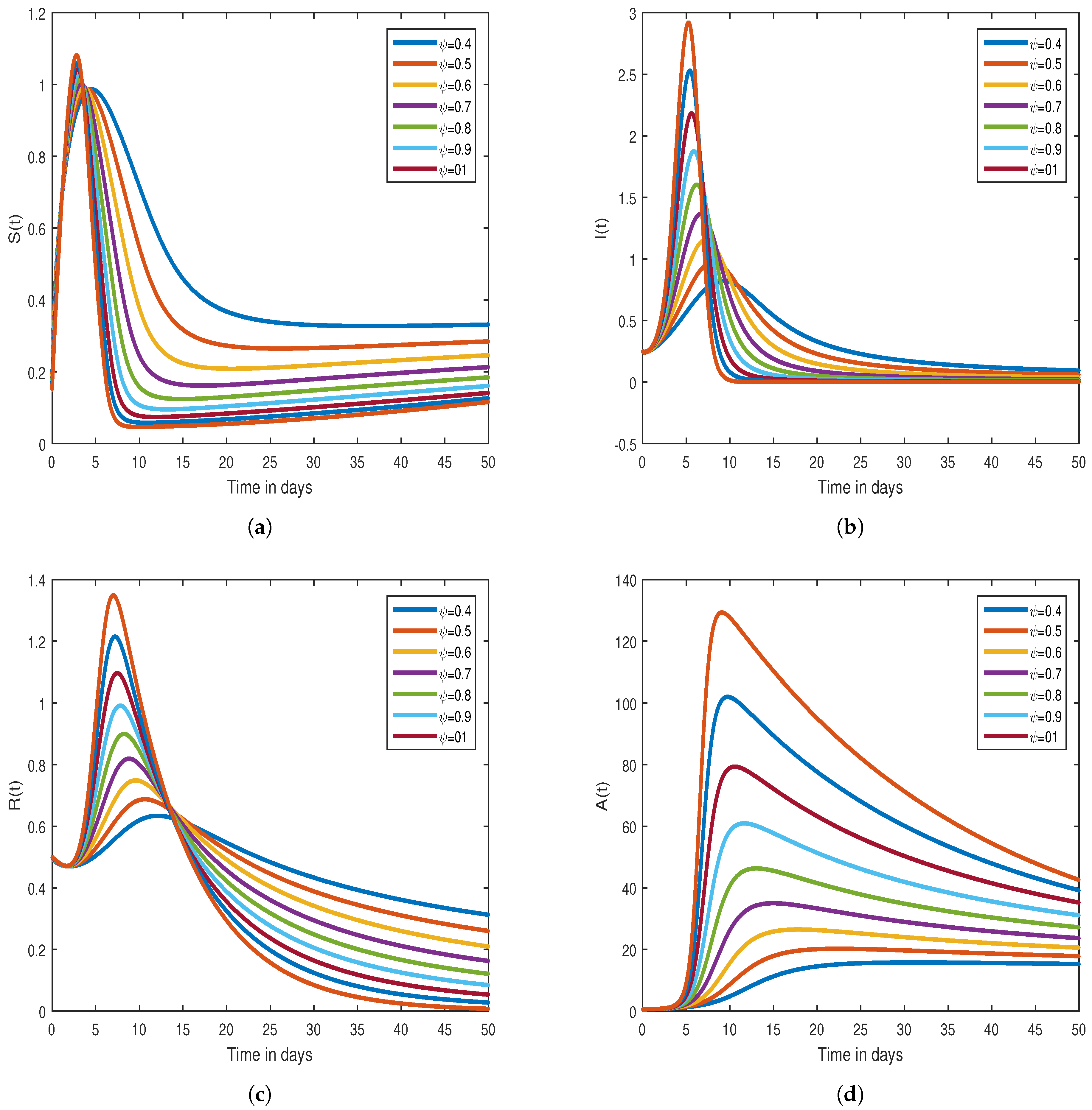

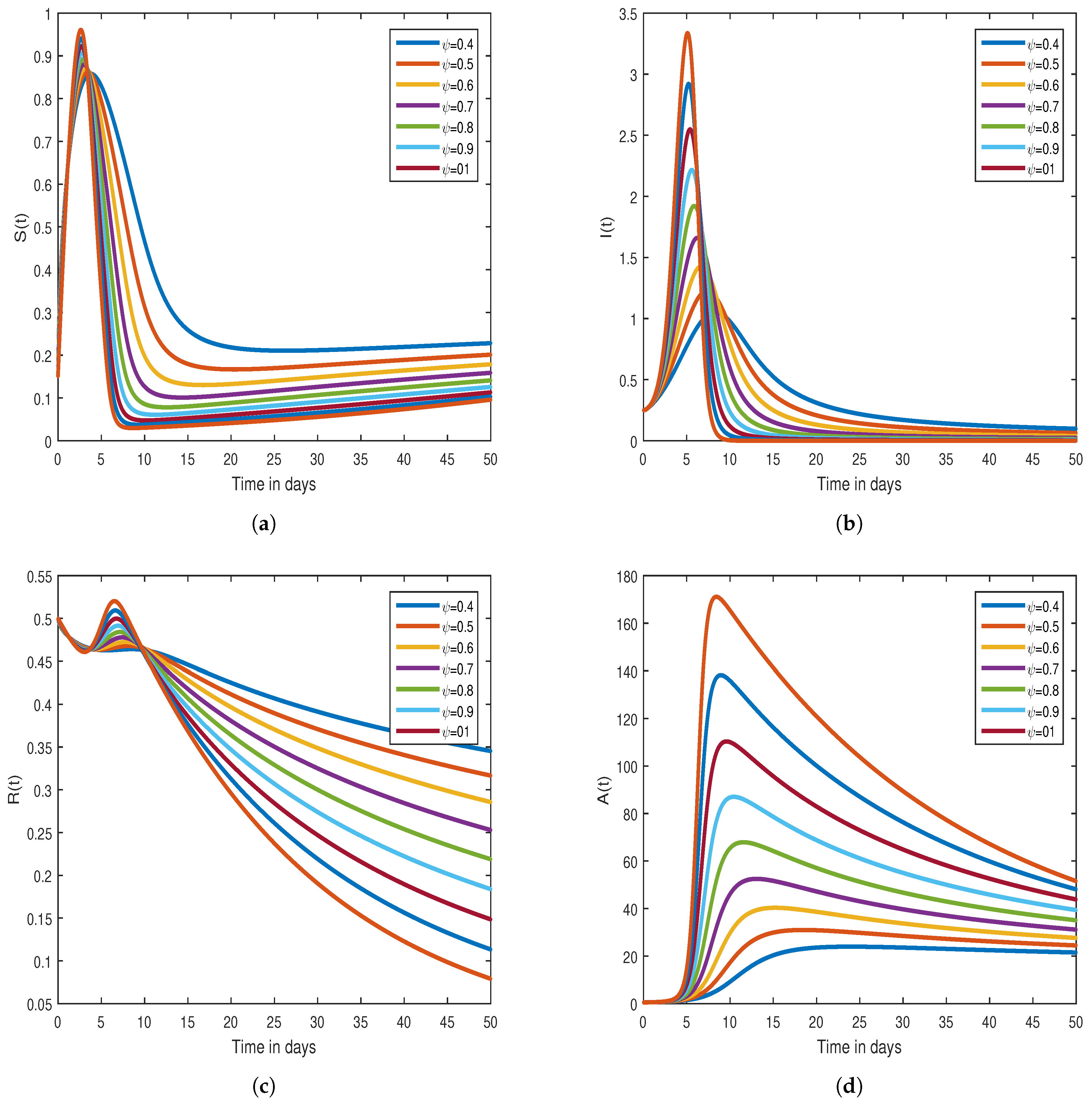
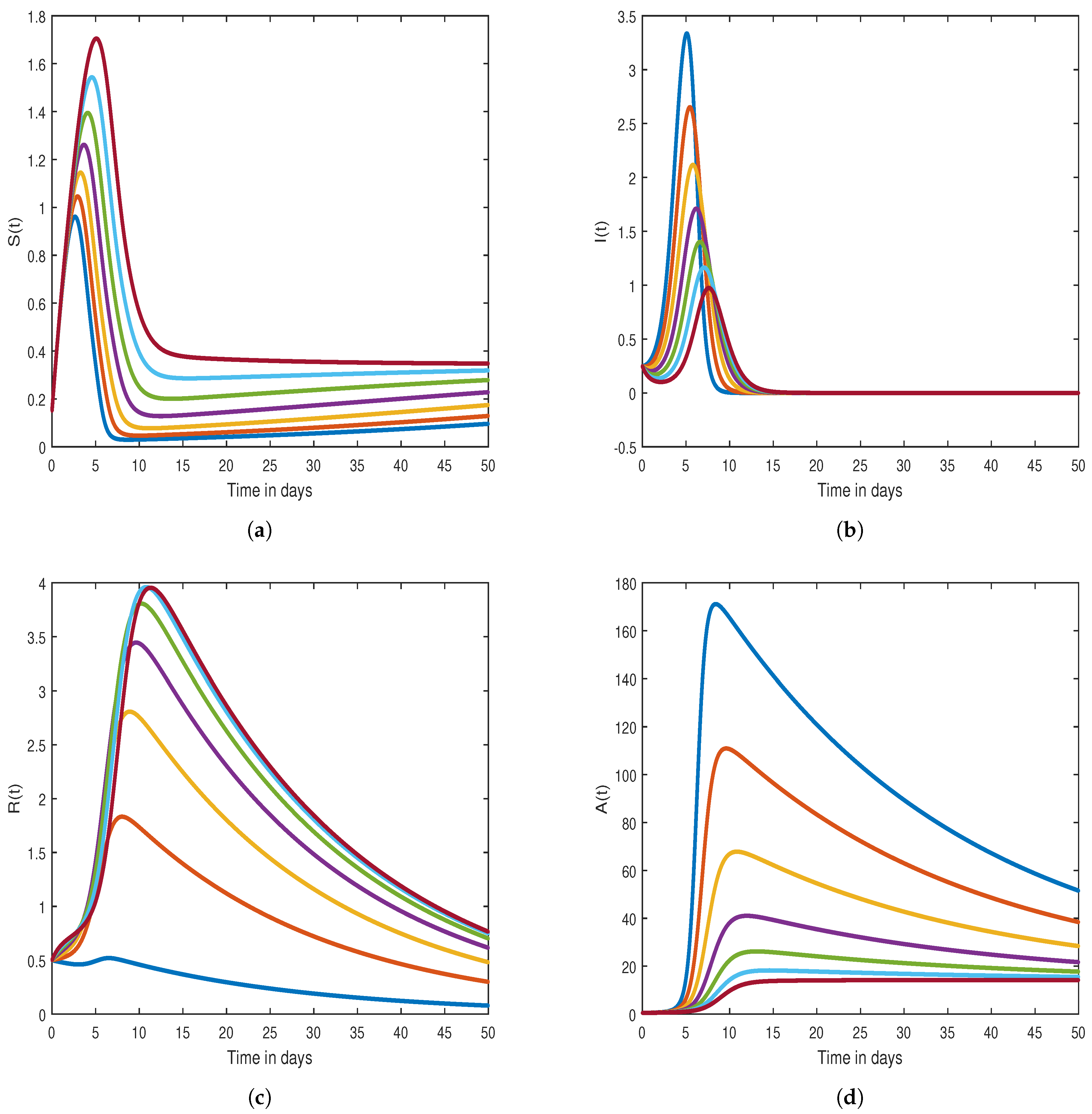
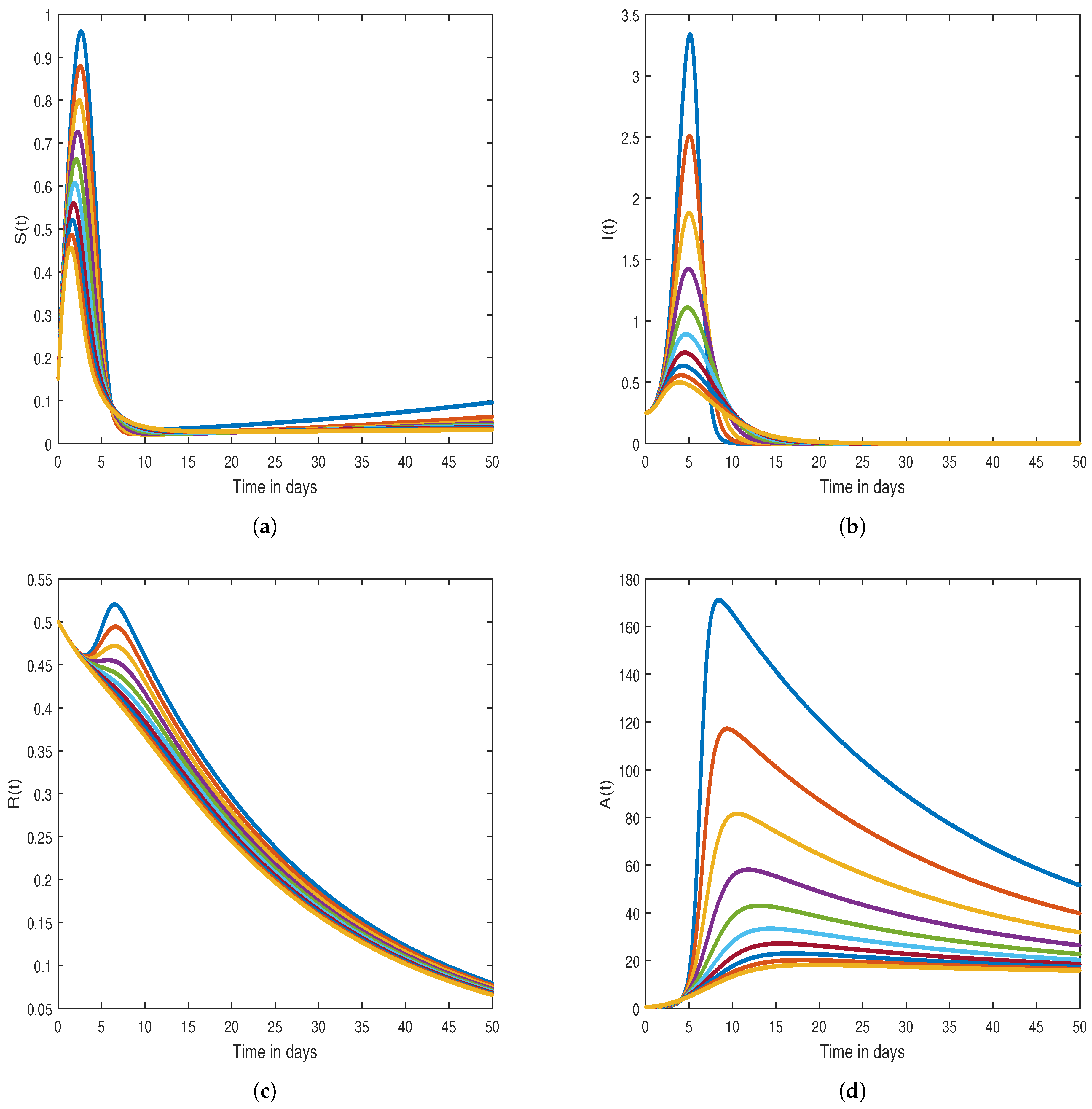
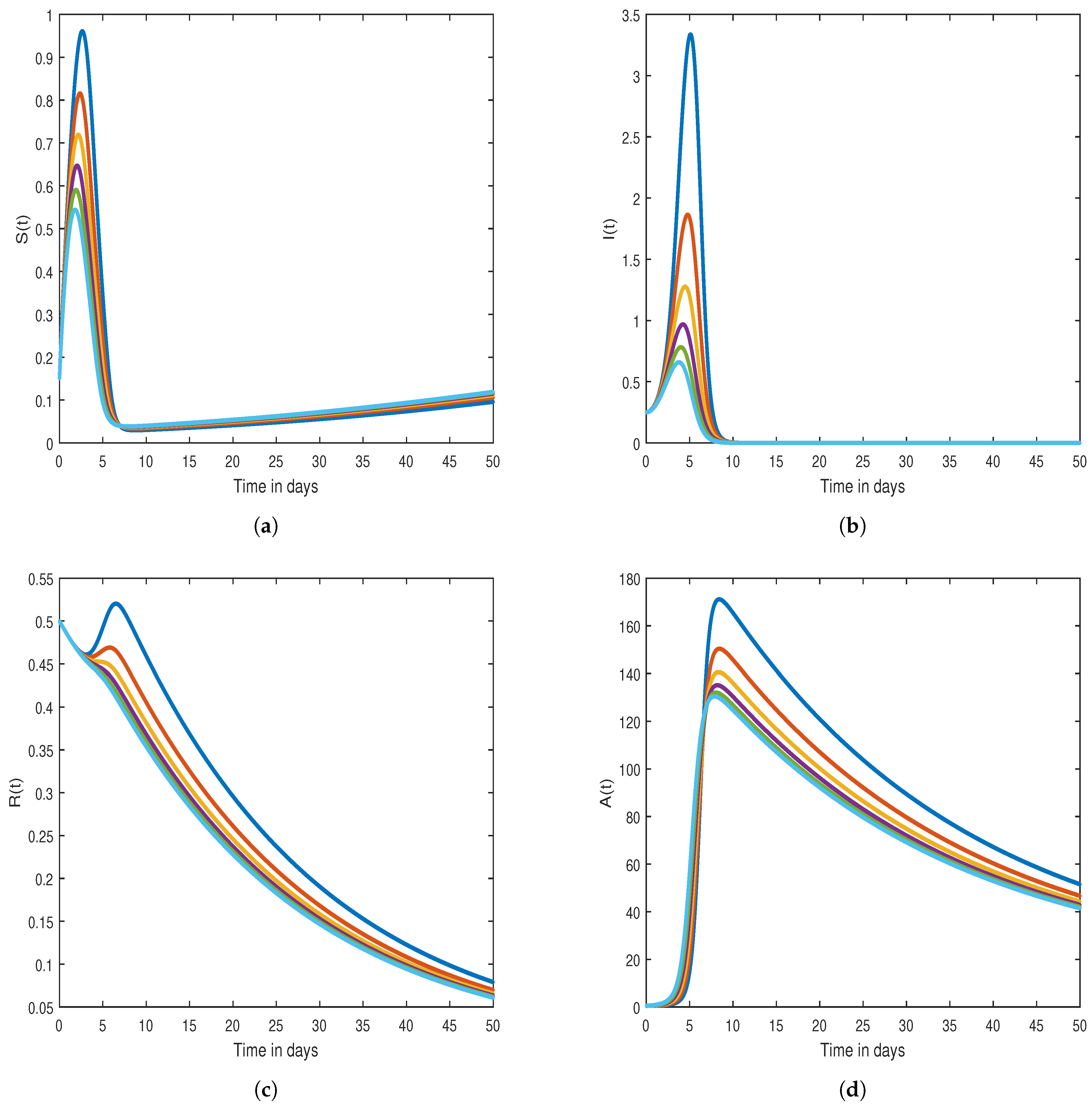

Disclaimer/Publisher’s Note: The statements, opinions and data contained in all publications are solely those of the individual author(s) and contributor(s) and not of MDPI and/or the editor(s). MDPI and/or the editor(s) disclaim responsibility for any injury to people or property resulting from any ideas, methods, instructions or products referred to in the content. |
© 2023 by the authors. Licensee MDPI, Basel, Switzerland. This article is an open access article distributed under the terms and conditions of the Creative Commons Attribution (CC BY) license (https://creativecommons.org/licenses/by/4.0/).
Share and Cite
Zarin, R.; Khaliq, H.; Khan, A.; Ahmed, I.; Humphries, U.W. A Numerical Study Based on Haar Wavelet Collocation Methods of Fractional-Order Antidotal Computer Virus Model. Symmetry 2023, 15, 621. https://doi.org/10.3390/sym15030621
Zarin R, Khaliq H, Khan A, Ahmed I, Humphries UW. A Numerical Study Based on Haar Wavelet Collocation Methods of Fractional-Order Antidotal Computer Virus Model. Symmetry. 2023; 15(3):621. https://doi.org/10.3390/sym15030621
Chicago/Turabian StyleZarin, Rahat, Hammad Khaliq, Amir Khan, Iftikhar Ahmed, and Usa Wannasingha Humphries. 2023. "A Numerical Study Based on Haar Wavelet Collocation Methods of Fractional-Order Antidotal Computer Virus Model" Symmetry 15, no. 3: 621. https://doi.org/10.3390/sym15030621
APA StyleZarin, R., Khaliq, H., Khan, A., Ahmed, I., & Humphries, U. W. (2023). A Numerical Study Based on Haar Wavelet Collocation Methods of Fractional-Order Antidotal Computer Virus Model. Symmetry, 15(3), 621. https://doi.org/10.3390/sym15030621





